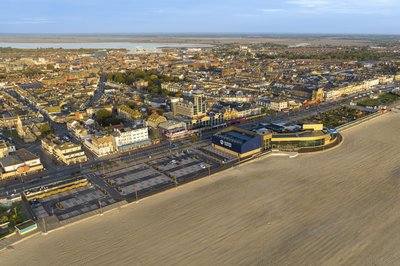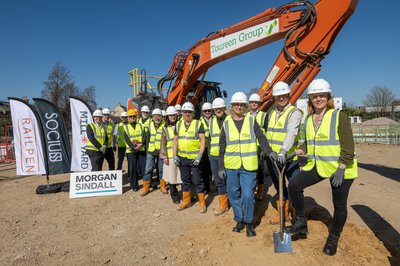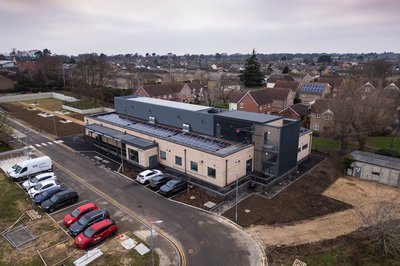Unity Campus Phase II
Our Morgan Sindall Eastern team completed Phase 2 of the £100m Unity Campus Research and Development masterplan in South Cambridgeshire, just before the 2024 new year. Having completed Phase 1 in 2019, Phase 2 sought to build upon the progress made at this innovation district by constructing three new flexible lab spaces, amassing over 88,000 sqft.
Along with the three laboratory spaces, a multistorey car park to increase parking capacity by 256 spaces, additional EV charging points and fit out to an existing office on the park was required.
Key Stats
- The project has been spread across three phases, which Morgan Sindall Construction East completed Phase 1 in 2020.
- Phase 2 includes construction of a new urban innovation village in the South of Cambridgeshire, providing over 260,000 sqft of Office spaces with the ability to be used as Laboratory space
- A Multistorey car park to increase parking capacity by 256 was also part of the scope of works
- Over £1.4m saved through a collaborative Value Engineering exercise
- BREEAM Excellent
- On time and On Budget
- Client Satisfaction 10/10
At a Glance
Budget
£39.5m
Completion
December 2023
Location
Sawston, Cambridge
Framework
N/A
Sector
Education, Higher
The Howard Group wider Vision
Howard Group acquired eleven acres of land in 2011 with a vision of repurposing, what was a former tannery site, into a new urban innovation district in the heart of the Cambridgeshire Countryside.
It was envisioned by Howard Group that this innovation park would promote interaction and collaboration amongst the businesses within the park. This would not only need to be achieved through the type of occupants at this park, but also through the buildings designs and the potential for collaborative spaces within these buildings. It was also fundamental that the building would be built sustainably, which, life science buildings have historically been challenging to build.

Design approach to foster flexibility and collaboration
Buildings are changing their functions and evolving all the time, which meant the building would need to be future proofed and adaptable for a range of different businesses. Each building was designed to three storeys high, to give tenants more space and the ability to manipulate the building to suit their needs. It allows for either three occupied storeys of offices or, in some instances (where there are highly serviced laboratories) two occupied levels with one level of plant.
Within these buildings, the creation of streets, boulevards, squares, and breakout areas were key to ensure the space would achieve its overall aim.
Taken together, the three buildings share a strict design code whilst giving each its own identity. Buildings A1 and A2 share an identical modular cladding with extruded fins of differing bronze tones whereas Building B is clad in a dark grey soft metal standing seam cladding.
Building on the industrial legacy of the nearby villages of Sawston and Pampisford, the bold urban aesthetic of the buildings is being offset by a network of connected green spaces and water meadows as well as a landscaped courtyard with a multi-purpose clubhouse.
The greenest lab in the South Cambridgeshire Cluster
Part of the aspiration for Unity Campus was, to demonstrate the possibility of constructing low carbon laboratories which could stand the test of time; efficiently and cost effectively. It was therefore a requirement that the project would achieve BREAAM Excellent, along with other carbon targets. The design approach would be key, which started early in the pre-construction phase and was realised during the main build.
The team baselined the ‘as-designed’ carbon performance, then used *CarboniCa to track changes and show the sustainability impact of design decisions in real-time. The use of CarboniCa throughout the design stages to model change supported the team to make decisions, such as:
- Swapping SFS for timber SIPS (saving 104 tCO2e),
- Replacing 50% of the cement content in the concrete foundations with GGBS (128 tCO2e),
- Using roll-out steel reinforcement as a low-waste, lower carbon alternative (23.5 tCO2e).

These models were updated during the build process to produce an accurate as-built model, including all available Environmental Product Declarations (EPDs) for specific materials, exact delivered and wasted quantities, and the distance travelled to site for delivery.
Whilst it wasn’t originally in the project brief to improve and monitor its operational energy, the approach changed during the design stage in response to market trends and the whole team’s drive for sustainable outcomes. This led to design changes such as improving the specification of the glazing for enhanced U-values which exceeded building regulations. A new natural ventilation solution was also adopted, to enable cross ventilation to all office areas, saving on operational energy requirements.
The project was the first Morgan Sindall Construction site to go diesel-free, achieving a carbon intensity for site operations of 187 kgCO2e/£100k project value, saving over 230 tCO2e.The team encouraged and supported the Supply Chain to adopt Green D+ HVO fuel, a sustainable alternative to diesel for plant, or electric-powered machinery. These alternatives also had an added air quality benefit, reducing harmful exhaust emissions. The success of this initiative has also given the business confidence to mandate this change nationally.
Over £32m reinvested back into the community
Constructing buildings and supporting the local community is a vital requirement for our projects. Whether that’s through supporting the next generation, supporting local members of the community or local businesses, our project teams always strive to provide more than just the building.

96 Weeks of Apprenticeship Training Delivered FutureIN
A partnership was formed between Howard Group, TrAc Apprenticeships and Morgan Sindall to set up a new scheme called FutureIN. FutureIN is designed to provide vulnerable people, homeless people, or those at risk of homelessness, an opportunity to qualify as an apprentice. The team supported six pupils into apprenticeships, all of which, are now working towards their apprenticeship qualification. In addition to the FutureIN apprentices, there were also five other apprentices who helped deliver the project, contributing over 96 weeks of apprenticeship training on site.
Combat2Coffee
Our project team supported Combat2Coffee, which is a Community Interest Company set up to support recovering veterans and their families with a safe space to open up about any mental health difficulties they’re facing. Combat2Coffee set up mobile coffee hubs and coffee events to encourage these conversations - over a coffee. They visited the Unity Campus site, which was well attended by site workforce, client team, Morgan Sindall staff and local residents.
Gallery
Related News
NEWS

Building Community in Great Yarmouth
The UK's coastal communities face unique challenges. Around 10% of the nation's population lives in coastal towns and cities – places that have experienced decades of decline and where …
NEWS

Groundbreaking ceremony marks official start on site for Mill Yard development
A major milestone was reached on Monday 7 April as local councillors, residents, members of the community and the development project team all attended an official groundbreaking ceremony for …
NEWS

Morgan Sindall completes Newmarket Community Diagnostic Centre
A new Community Diagnostic Centre (CDC) at the Newmarket Community Hospital has been completed by Morgan Sindall Construction and handed over to West Suffolk NHS Foundation Trust (WSFT).
















